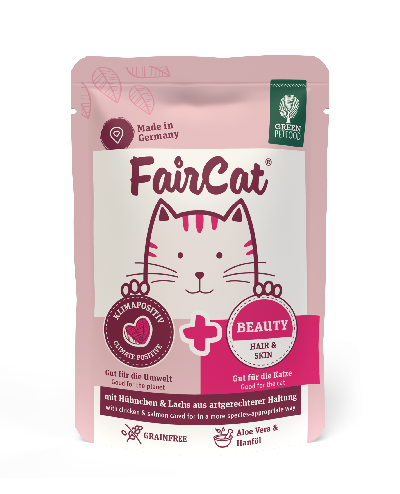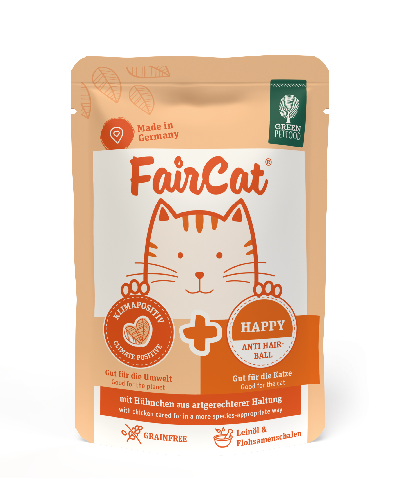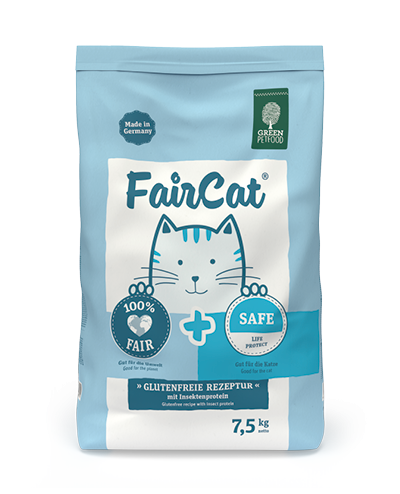What can cats not eat – 16 tips for proper cat nutrition
Cats are naturally rather fussy and have discerning culinary tastes. It’s not unusual for them to leave a meal uneaten if it is not completely fresh and served at the right temperature in their favourite bowl. Despite high expectations when it comes to food, sometimes your cat’s curiosity will get the better of them. Whether it is houseplants, leftover kitchen waste or tasty treats offered by owners with the best of intentions – certain foods should be off limits for cats. Let us answer the question: What can cats not eat?
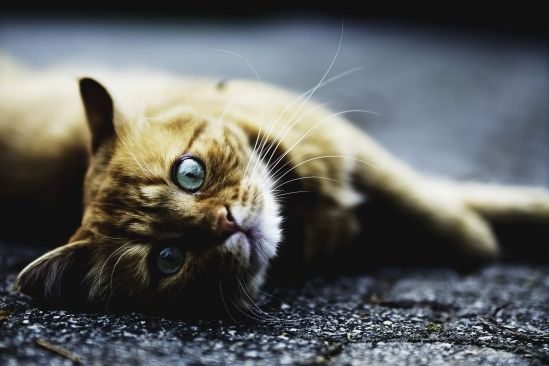
Some things that are good for humans can be toxic for cats
New cat owners are often very unsure. What is my cat allowed to eat? Inexperienced cat owners are particularly anxious about getting their pet’s diet wrong. After all, lots of human treats are poisonous for cats – which you only discover when your cat suddenly suffers from diarrhoea or vomiting after a delicious snack. What is banned and what is allowed in moderation? What do cats like to eat other than cat food?
Can my cat drink milk?
Most people are familiar with the image of a cat lapping up milk from a bowl. On farms, milk from the cows often still ends up in the cat’s bowl and nobody bats an eyelid. And yet this ingredient is often listed as a prohibited food. What is going on? Is milk actually toxic for cats? Absolutely not. But ... in the same way that many humans are lactose intolerant, most adult cats can no longer tolerate dairy products containing lactose. They won’t die and most will not get seriously ill as a result; however, most cats can only digest lactose with difficultyor not at all and this can result in diarrhoea.
Tip 1:
If you want to treat your cat occasionally to milk or another product containing lactose, first give them a small amount to test whether their digestive system can handle this delicious liquid. If you want to be absolutely sure, you can opt for lactose-free milk designed for human consumption. Unfortunately, special cat milk contains high amounts of sugar and other unnecessary additives as well as being totally overpriced.
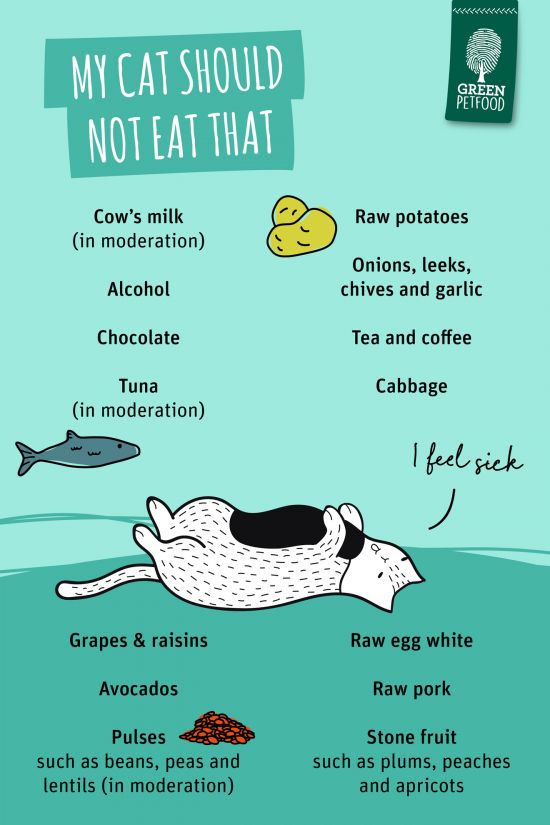
Can my cat eat cheese?
Most cats turn into persistent miaowing pests when they sniff cheese. Cats love cheese – and they are not usually fussy about the type: soft, hard or cream cheese. Having said that, cheese usually belongs to the same category as milk – this delicious food, depending on the precise variety, contains varying amounts of lactose, which can cause mild digestive problems or even severe diarrhoea.
And, in case you were wondering, yogurt, butter and cottage cheese all belong in this category.
Even if your cat can stomach cheese, this is a protein-rich, high-fat food that is not necessarily beneficial. Your cat already gets all its requirements for these important nutrients from meat.
Too much cheese can result in an excessive supply of protein and fat.
For this reason, you should only serve your cat cheese and other dairy products in small quantities, if at all.
The spices and salt contained in these products are another reason to avoid them.
Tip 2:
If your cat is a big cheese fan and doesn’t get an upset stomach in response, you can offer the occasional little piece. Cream cheese, soft cheese and hard cheese that has only been matured for a short period contain more lactose than varieties that have undergone a longer maturation period.
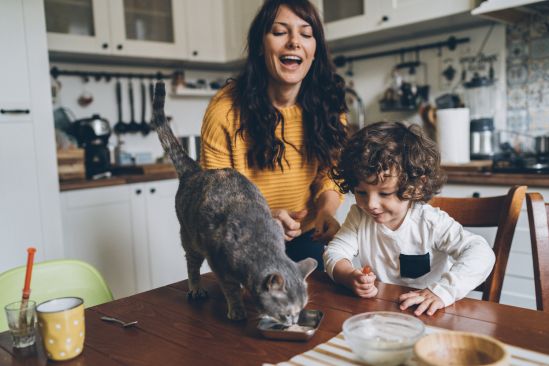
Can my cat eat tinned tuna?
The smell of tuna from an open tin will attract pretty much any cat’s attention. Most cats are happy to skip their mouse meals for a taste of this firm fish. However: tuna can contain high quantities of the organic compound methylmercury. This toxic substance is absorbed from the prey consumed by these predatory fish as they swim through the oceans: mercury accumulates in plankton, which is then consumed by plankton-eating fish. But it originates from industrial contamination of the oceans. Mercury can cause poisoning symptoms in cats.
Tip 3:
You do not need to completely withhold your cat’s favourite fish, but tuna should only be eaten very occasionally and in small quantities. Standard tinned tuna generally contains lots of salt and other spices, so it is better to opt for tinned pet food containing tuna or fresh tuna that you have cooked. Raw tuna contains the enzyme thiaminase, which makes thiamine (i.e. vitamin B1) unusable by the body. Raw fish also contains trimethylamine, an organic compound that binds iron and can cause anaemia if consumed for an extended period. Check the origin and fishing method when buying tuna.
Can my cat eat raw meat?
This question will elicit a weary smile from proponents of the BARF (biologically appropriate raw food) diet – they offer their cats a daily meal that is as natural as possible, consisting of fresh meat and appropriate ingredients. BARF fans will even put raw chicken in their cat’s bowl (which many chefs fear as a potential source of salmonella). But not all cats tolerate raw meat equally well. Cats that are used to eating prepared food often do not get on with the natural microbial content in raw meat compared with cats that have followed a BARF diet and whose digestive tracts are accustomed to these bacterial demands. Immunocompromised animals are particularly at risk (irrespective of the type of food being offered) and can suffer serious illnesses including blood stream infections. But what meat are cats allowed to eat raw? In principle they can eat anything – the only exception is pork and wild boar meat. These varieties of meat should not be fed raw due to the risk of Aujeszky's disease (AD), which can be fatal for cats. This disease has been eradicated in domestic pigs, which act as hosts for the herpes virus (Germany has been AD-free since 2003), however cases of the Aujeszky virus do occasionally crop up in wild pigs. In addition, it is impossible to guarantee that pork has not been sourced from abroad.
Note: The risk of infection is always higher from raw meat than from prepared food. The possibility of transmitting germs to humans can also not be ruled out, which is a relevant consideration particularly for pregnant women, new-born babies, and older people. The same caution should be applied for preparing meat in general.
Tip 4:
If you want to vary your cat’s diet with some raw meat but you are worried about the increased risk of infection, you can also cook the piece of meat.
Can my cat eat raw eggs?
Eggs are healthy for cats because they contain lots of amino acids and vitamins. However, the egg white (unlike the yolk) should never be offered raw. Raw egg white contains high levels of avidin and ovomucin.
Avidin is a glycoprotein that can bind vitamin B7. If a cat is fed egg white too often, their body will become unable to absorb this important vitamin – also known as biotin – either from their food or from the substance produced by microorganisms in their intestinal flora. This can result in a biotin deficiency. When egg whites are cooked, the avidin is denatured and can no longer form an insoluble compound with the biotin found in food. The risk of a vitamin B7 deficiency is thus avoided.
The protein ovomucin, on the other hand, is a trypsin inhibitor, which is a vital enzyme in the digestive tract. If trypsin is inhibited, this can cause digestive problems.
Tip 5:
You are on the safe side with a softly boiled egg or fried egg with a runny yolk.
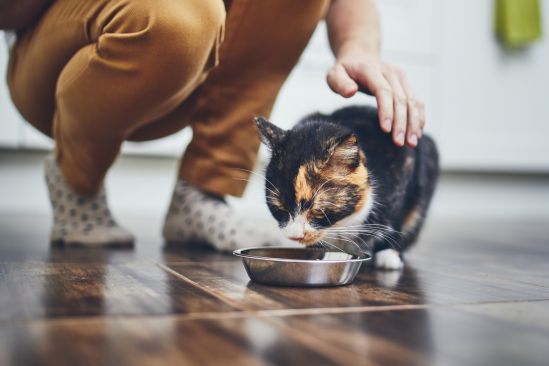
Can my cat eat ham, salami or liver sausage?
Cold meats are not toxic for cats; however, they should only be offered occasionally. Cooked and smoked ham, salami and liver sausage contain lots of spices and are usually high in salt – ingredients that have no place in your cat’s bowl. Cured pork products that have not been completely cooked have the same issue as described for raw pork.
Tip 6:
You can occasionally relent and share some sausage, ham or salami with your cat as long as the relevant item is completely cooked. But don’t let it become a habit.
Can my cat eat fruit?
You do not need to be an experienced cat owner to know that cats are not vegan by nature. You are unlikely to find them nibbling on an apple when they could be hunting down a mouse. Nonetheless, there are a couple of types of fruit that most cats like, which can introduce some welcome variety to their diet. What fruit can my cat eat? Bananas are a definite highlight when it comes to fruit thanks to their sweet taste and soft consistency. Most cats will also enthusiastically consume watermelon.
What fruit is my cat not allowed to eat?
Fruits that are literally forbidden include stone fruit such as plums, peaches and apricots. The stones contain hydrocyanic acid which, depending on the dose, can cause poisoning within a few seconds, potentially resulting in death a short time later due to asphyxiation. These fruit stones are even more dangerous for dogs because they tend to bite hard objects when playing.
Grapes and raisins should also be avoided on the feline menu plan. While most cats don’t like these fruits, if they do get carried away and eat them this can cause stomach pains and diarrhoea, or even kidney damage and death. It is still not known what the toxic substance in the grapes is and the dangerous dose has only been researched in dogs.
Tip 7:
Serve melon fresh, without the skin and chopped up small.
Can my cat eat vegetables?
Unlike dogs, who eat all sorts of vegetables, cats are committed carnivores who are likely to turn their noses up at vegetables. In the wild, cats are predators whose only plant-based intake is whatever is found in the stomach of their prey.
Not all vegetables are suitable for cats. If humans can only eat something when it is cooked, cats will also generally tolerate these items in the same form. Caution is required with cabbage and pulses: many of these foods can cause unpleasant flatulence or stomach pain. Alliums like onions, chives and garlic are also dangerous for cats due to the sulphur compounds they contain in any form – raw, fried or boiled. Raw potatoes are another item that must not go into your cat’s food dish due to their high solanine content and starch levels.
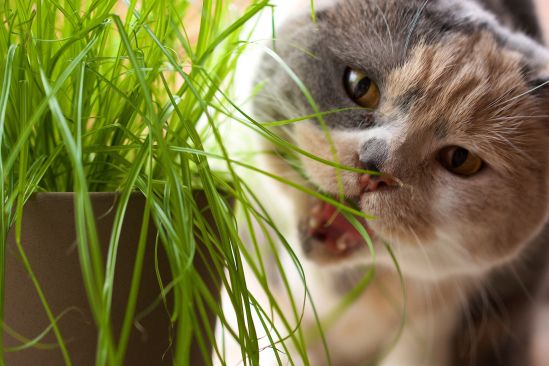
The most appropriate options are spinach, parsley (in small quantities) and shoots, which most cats will enjoy eating. There are even cats who will prefer lamb's lettuce to cat grass. However, the latter should always be on offer as it is a valuable digestive aid, which can make it easier for the cat to get rid of hairballs.
The same applies for the cooking water left after boiling potatoes: the solanine it contains can cause stomach cramps, flu symptoms and general disorientation. Unripe tomatoes, green peppers and aubergines all contain atropine, which can cause cardiac arrythmia in cats.
Tip 8:
To improve tolerance of vegetables, you can grate them finely using a kitchen grater. Then pour over boiling water and leave to stand for 10 minutes. Finely chopped parsley or finely grated carrots can be drizzled with high-quality vegetable oil to introduce some variety to your cat’s diet, as well being a source of valuable vitamins and fatty acids.
Seasonal calendar
Here you can find out which fruits and vegetables are in season and good for your cat. So you can provide your four-legged friend with healthy snacks with a clear conscience!
Can my cat eat flies?
Cats are natural predators and will hunt pretty much anything that moves, not just mice and birds. Flies are a little everyday treat in cat’s lives. They ensure species-appropriate activity, offer a physical challenge, and represent a small but nonetheless enjoyable delicacy. Cats fulfil their urge to play – before actually eating the fly, they usually just lick off the wings to stop the insect flying away. Once the fly has been physically disabled in this way, it is an easy victim, to be used by the cat as a living puck in a gruesome game of hockey. Flies and insects are a natural part of cats’ diet in the wild too, where they are a valuable source of high-quality protein.
Tip 9:
Sometimes, when cats are playing, they can get a bit too close to dangerous insects like bees or wasps. Take care that your cat doesn’t get stung.
Can cats eat dog food?
Dog food is not toxic for cats, so you don’t need to panic if your cat occasionally helps himself to whatever is in the dog’s bowl. However, this shouldn’t become a regular habit because standard dog food does not have a suitable nutrient profile for cats. Cats need food that is very high in protein and taurine because they cannot synthesise amino sulfonic acid themselves. Semi-moist complete dog food can also contain propylene glycol as a preservative. This is not suitable for cats.
Tip 10:
If your cat regularly steals dog food, let it eat in a separate room and dispose of any leftover food in the dog’s bowl.
Can my cat eat bread?
Most cats are not big bread fans – and that's for the best. Bread is not recommended for cats due to its imbalanced composition. Special caution required for mould: mouldy bread can cause vomiting, muscle tremors, rapid breathing, cardiac arrythmia and aggressivity. Sometimes cramps may also occur.
Tip 11:
If your cat likes to chew on something hard, it is best to offer snacks that have been specially designed to meet cats’ needs rather than bread.
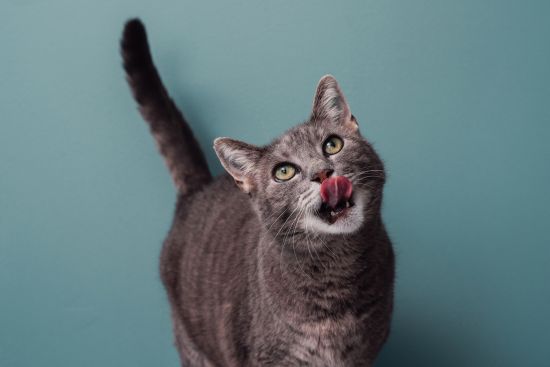
My cat has kidney disease, what can it eat?
Between 30 and 40 percent of all cats over the age of 10 suffer from renal insufficiency. The poorer the kidney function, the worse the animal’s overall condition will be: the cat will eat less well and the concentration of substances that are normally excreted in urine will rise, in particular urea, creatinine and phosphate. In later stages, the cat may experience elevated blood pressure and metabolic acidosis. A change of food will be necessary in this case. Cats suffering from kidney disease need a special diet to reduce strain on the organ and enhance its ability to eliminate waste products. The disease is incurable, but kidney damage generally only develops slowly and can be significantly slowed through an appropriate diet.
A kidney-friendly diet has the following foundation:
- Less protein, but high in quality
- Less phosphorus
It is essential to reduce the phosphorus content in food. If too much phosphorous is consumed, this can speed up the disease process. The consequence will be increased calcium phosphate deposits in the residual kidney, resulting in a further reduction in its capacity. Some diets that are suitable for kidney disease contain carbohydrates that can be fermented by microbes, which can lower the pH-value in the rear digestive tract. This causes a shift in the equilibrium from ammonia to ammonium. Ammonium is excreted via the intestine and so does not put any strain on the endogenous excretion processes. N-3 fatty acids can have a positive impact on inflammation markers and on renal perfusion. Fish oil is a good source.
- More fat
Cats suffering from kidney disease generally eat poorly. The fat content in their food should be increased to combat weight loss and stimulate their appetite. Fat is an excellent flavour carrier that puts minimal strain on the kidneys. The fattier the meat, the less protein it contains – and that also reduces the strain on the kidneys. Ideal options include goose, duck, fatty beef, cooked pork, salmon or mackerel. You can also add various animal fats, ideally a fish oil.
- Adequate potassium, sodium as required
Due to poor reabsorption of potassium from urine, it is important to ensure an adequate potassium supply. Excess sodium should be avoided due to the negative impact on high blood pressure.
- Sufficient vitamins
It is also important to provide an appropriate supply of soluble vitamins and vitamin D.
- Sufficient water
You should allow your cat to drink enough; indeed, they may need some encouragement in this regard. Even if the urge to urinate is higher, you must not restrict the cat’s access to drinking water or limit the quantity of water to reduce the volume of urine.
Tip 12:
Unfortunately, cats suffering from kidney disease must not be given treats or chews.
Can my cat eat after their neutering procedure?
In the period shortly after the operation, you can offer your cat some fresh water, but no food. As long as the anaesthetic is in the cat’s bloodstream, there is a risk of vomiting if food is consumed. Food can be offered once the anaesthesia has worn off and your pet is coordinated and appears alert.
Tip 13:
It can take up to two days for your cat to eat normally again after being neutered.
Non-toxic plants for cats
When cats eat plants, they rid their stomach of hair consumed when they clean their fur. Cat grass is a popular option to help cats get rid of hairballs. However, cats also sometimes get bored or curious and chew on leaves and flowers, without necessarily distinguishing between harmful and harmless plants. Make sure you have a safe environment for your cat and avoid toxic plants that could cause serious harm.
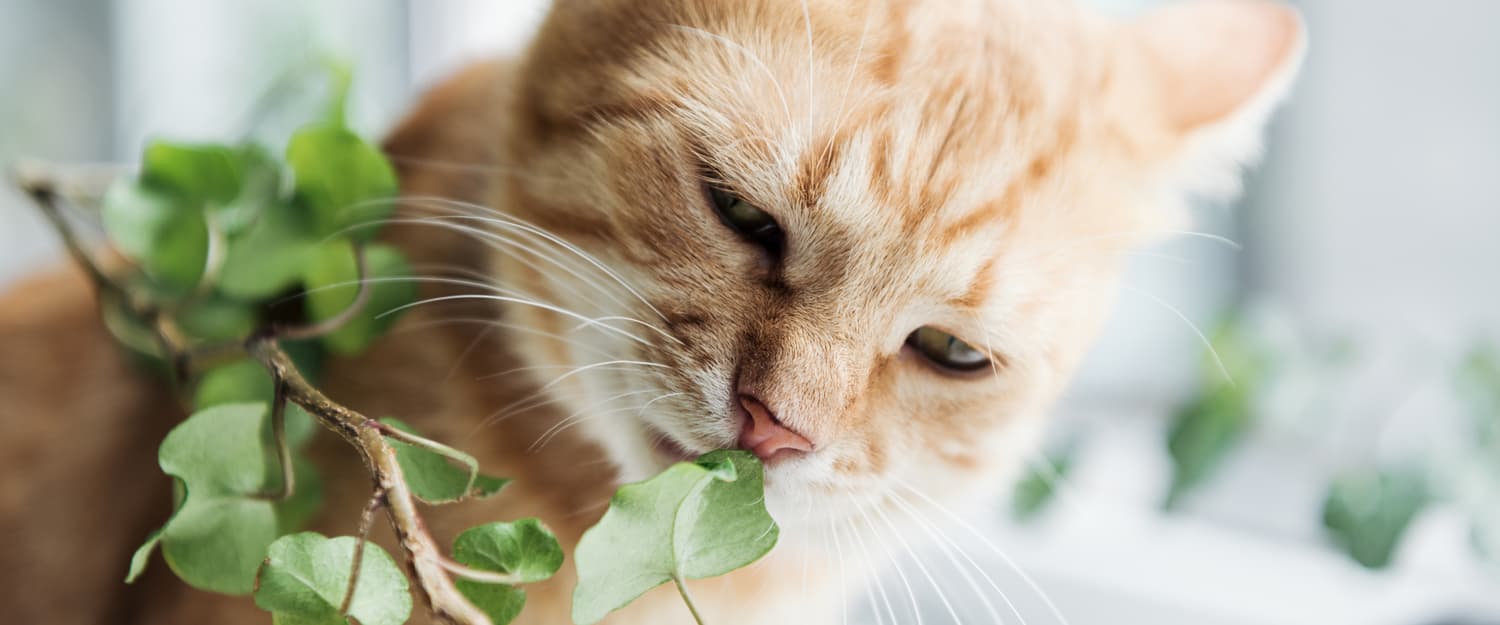
The following plants are poisonous for cats:
- Philodendron
- Weeping fig
- Christmas rose
- Angel’s trumpet
- Devil’s ivy
- Giant Taro
- Swiss cheese plant
- Spring crocus
- Garden tulip
- Jimsonweed
- Laburnum
- Hyacinth
- Tuberous begonias
- Lily of the valley
- Oleander
- Daffodils
- Easter lily
- Sago palms
- Snowdrops
- Wax plant
- Lantana
- Poinsettia
- Zamioculcas
- Arum lily
- Persian cyclamen
Tip 14:
Our cats love catnip, valerian and cat grass. These can be used to turn your home into a real jungle.
Can my cat eat chocolate?
As hard as it might be to resist sharing your favourite treat with your cat, chocolate really is off limits for cats. Cocoa contains theobromine, a substance that is highly toxic for house cats. Even in small quantities, this alkaloid can trigger poisoning symptoms such as vomiting, diarrhoea, panting, elevated respiration, muscle tremors and cramps. Eating chocolate can even result in death – a third of a bar of dark chocolate can be fatal for a cat that weighs 5 kg. The higher the cocoa content in the chocolate, the higher its theobromine content.
Tip 15:
You should completely avoid all chocolate and other cocoa products for your cat. Other sweet treats are also unhealthy. Even though white chocolate does not contain theobromine, it does contain lots of sugar – which is bad for the teeth, not to mention for blood sugar levels and the pancreas.
Can my cat eat crisps?
Common sense tells us that crisps are not good for us – and they certainly are not healthy for little cat’s bodies either. Too many spices, too much saturated fat. You are not doing your cat any favours if you share your crisps or salty treats with them. And you really have to ask whether your cat should be sipping your morning coffee or partaking in a beer at the end of the day – hands off! Stimulants such as alcohol, tea or coffee are highly toxic! Alcohol, coffee and tea (including herbal teas) can be toxic and cause damage to the liver, kidneys and gastrointestinal tract.
Tip 16:
Even if you are a junk food fan yourself and your cat is naturally curious – neither fast food nor stimulants are suitable for pets. Make sure you have some healthy cat treats on hand for when your cat starts begging for crisps or pretzels.
To conclude
Lots of foods that are fine for humans (maybe even highly prized culinary items) can be very dangerous for cats. Some houseplants and garden plants can also be a disaster for curious cats. Don’t try any experiments with your feline friend. The list of prohibited substances for your cat’s daily diet means you are well-equipped for everyday life.





